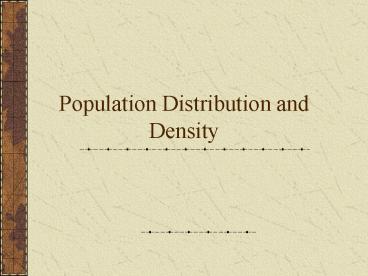Population Distribution and Density - PowerPoint PPT Presentation
1 / 24
Title:
Population Distribution and Density
Description:
... has a more efficient agricultural system? How can you tell? Essential Questions ... Compose a one-page response explaining what correlations, if any, did you ... – PowerPoint PPT presentation
Number of Views:885
Avg rating:3.0/5.0
Title: Population Distribution and Density
1
Population Distribution and Density
2
(No Transcript)
3
Culminating Assessment
- You will investigate the connections between
various environmental factors, human population
patterns and other population characteristics. - Next, you will apply your findings in the
creation of a map of an imaginary country or
region which will display the same connections
between environment and various population
characteristics.
4
Population Concentrations
- Two-thirds of world in the following regions
- East Asia (one-fifth of world)
- China most populous nation
- South Asia (one-fifth of world)
- India second most populous
- Europe (3rd largest concentration)
- Southeast Asia (4th largest concentration)
- Northeastern U.S. and West Africa
5
How did these regions get this way?
- Ecumene portion of Earths surface occupied by
permanent human settlement - Examine the spread of the ecumene.
- What might be its physical characteristics?
- What might be the physical characteristics of the
areas outside the ecumene? - Amend your original hypothesis.
6
(No Transcript)
7
(No Transcript)
8
(No Transcript)
9
(No Transcript)
10
Sparsely Populated Regions
- Dry Lands
- Wet Lands
- Cold Lands
- High Lands
11
Arithmetic Density
- Population divided by total land area
- High arithmetic density can mean two things
- Many people or little land
12
Example Malawi and Ecuador
- Population very close (both 13.9 million)
- Total area different (Malawi 118,480 sq. mi.,
Ecuador 283,560 sq. mi.) - Malawis density 117 people per sq. mi. VS.
Ecuadors density 49 people per sq. mi.) - What does arithmetic density tell us that crude
population cannot?
13
Practice with Arithmetic Density
- Country A Total land area 200,000 sq. mi.
crude population 800,000. Density? Is Country A
relatively crowded? - Country B Density 150 per sq. mi. Crude
population 6,000. Land area? - Country C Density 50 per sq. mi. Land area
200 sq. mi. Population?
14
Physiologic Density
- What doesnt arithmetic density tell us about the
land a population occupies? - Population divided by total arable land
- Example United States vs. Egypt
- 172 persons per sq. km vs. 2,580 persons per sq.
km - What does this mean?
- If Egypts arithmetic density is 75 persons per
sq. km, what does this tell us about the amount
of land suitable for agriculture?
15
Agricultural Density
- If two countries have similar physiological
densities, but produce different amounts of food,
what could account for this? - Ratio of farmers to arable land
- What can we conclude about technology and/or
economic conditions if agricultural density is
low? If its high?
16
Practice Quiz
- Arithmetic Density
- U.S. (31 per sq. km) vs. Canada (3 per sq. km)
- Which has either more people or less land?
- Physiologic Density
- India (699 per sq. km) vs. Japan (2,907 per sq.
km) - Which puts more pressure on the land to produce
enough food?
17
Practice Quiz cont.
- Agricultural Density
- Netherlands (72 per sq. km) vs. Bangladesh (1,158
per sq. km) - Which country has a more efficient agricultural
system? How can you tell?
18
Essential Questions
- Where is the worlds population distributed?
- Why is the worlds population distributed where
it is? - What are the consequences of this uneven
distribution?
19
Further Discussion
- Which of the essential questions does arithmetic
density help us to answer? - Which measure of density can help us to
understand why people live where they do? - What can physiological and agricultural density
together tell us about a countrys capacity to
feed its people?
20
Application Task
- Consider what possible correlations could exist
between these measures of density and other
population statistics. - In groups of 2-3, use the population statistics
packets and the maps on my teacher page and on
the board to formulate at least two new
hypotheses regarding the possible correlation
between a measure of density and another
population statistic.
21
Application Task cont.
- For example, is there a correlation between a
countrys physiological density and its infant
mortality rate? - Record your hypotheses, along with your
explanation as to why these might be correlated
on your hypothesis worksheet. - Determine your strongest hypothesis and be ready
to share with the class.
22
(No Transcript)
23
Begin your culminating assessment
- Conduct research to test your hypotheses and
consider how all three connect. - Use the provided map outlines to create two maps
of an imaginary country or region either
environmental and measure of density, or density
and another population statistic. - Compose a one-page response explaining what
correlations, if any, did you discover between
the three factors.
24
Resources
- www.prb.org (Population Reference Bureau)
- https//www.cia.gov/library/publications/the-world
-factbook/index.html (CIA World Factbook) - http//www.census.gov/ (Census Bureau)































